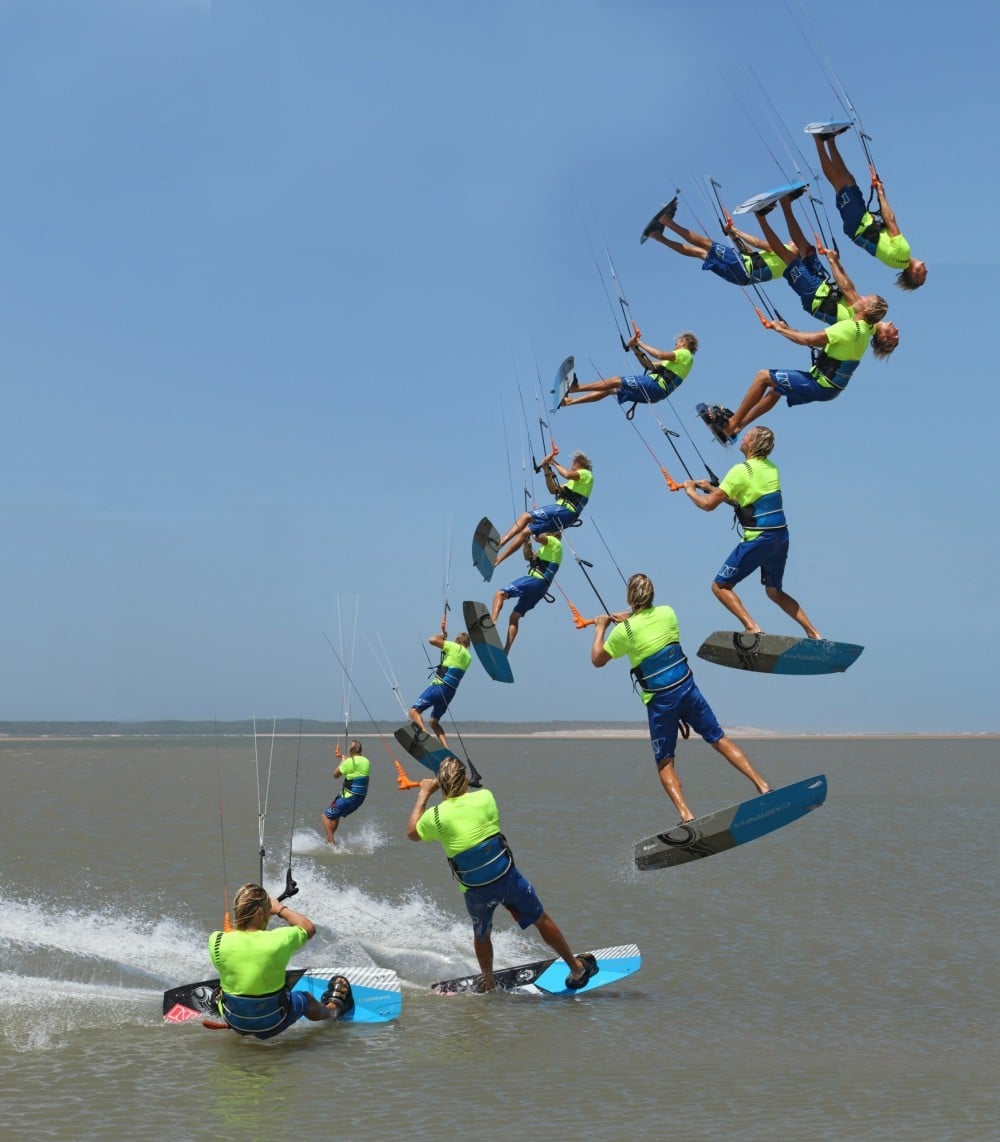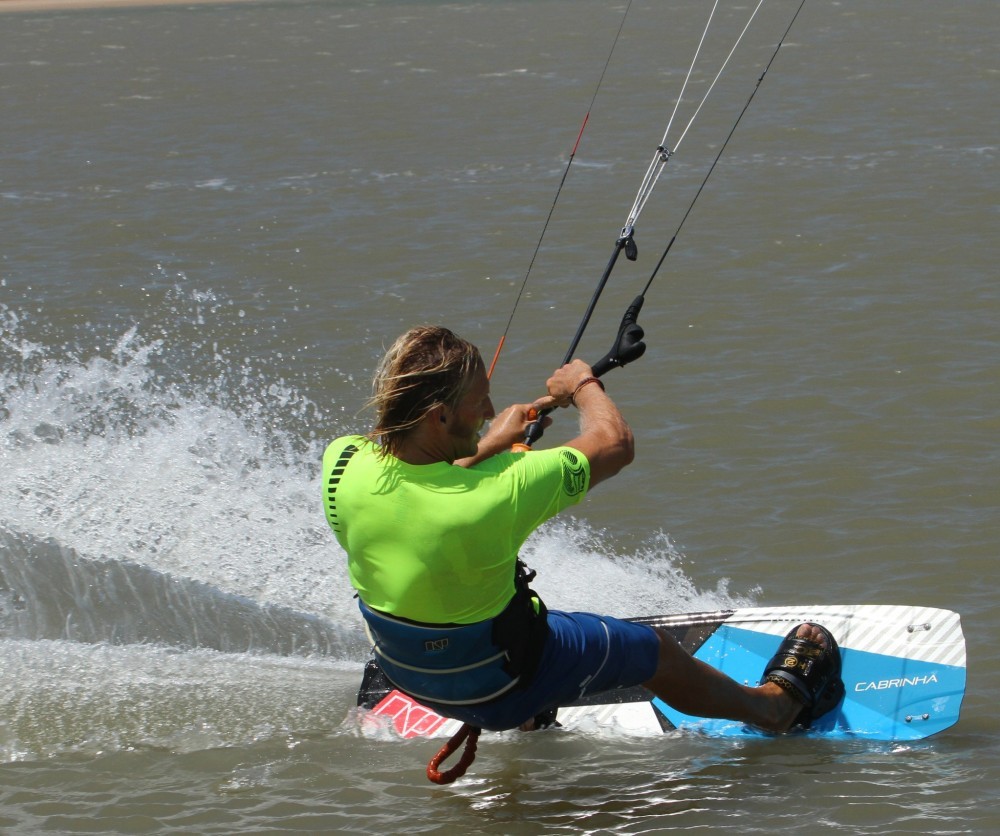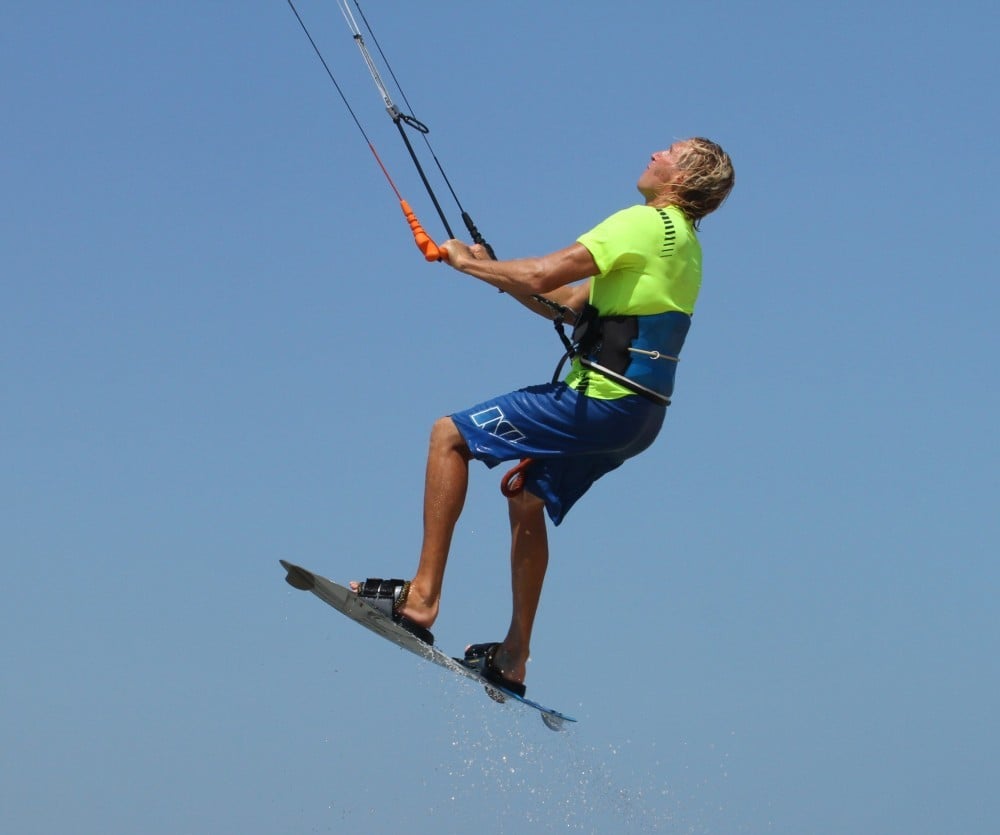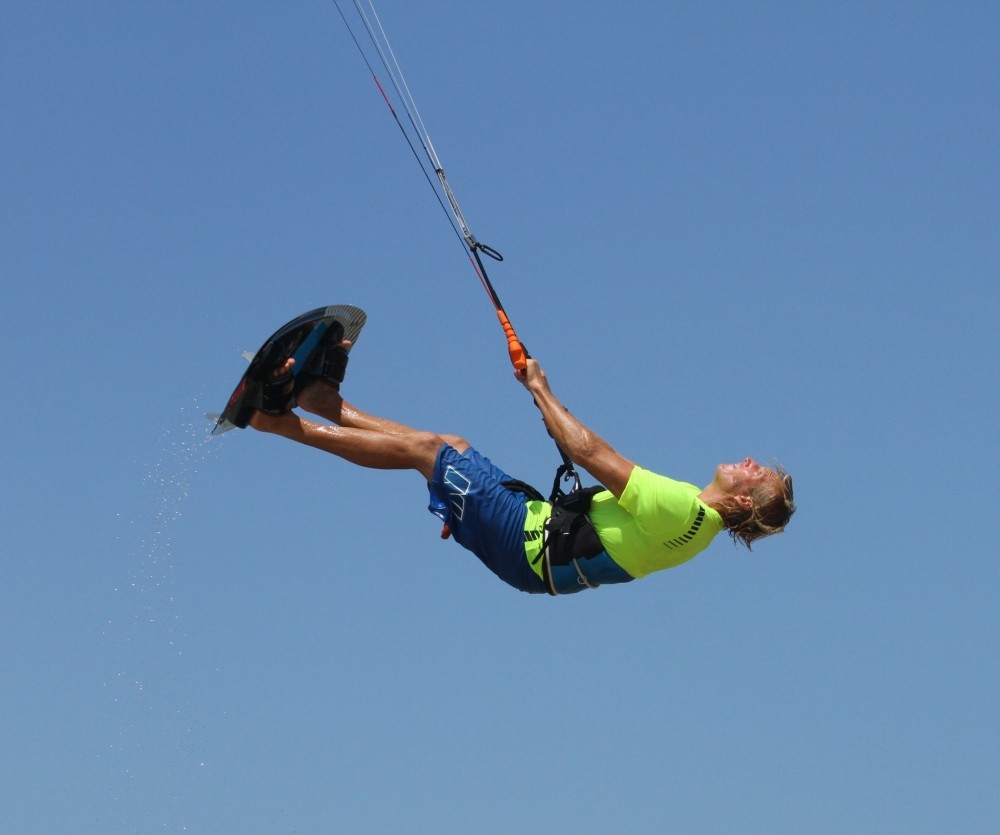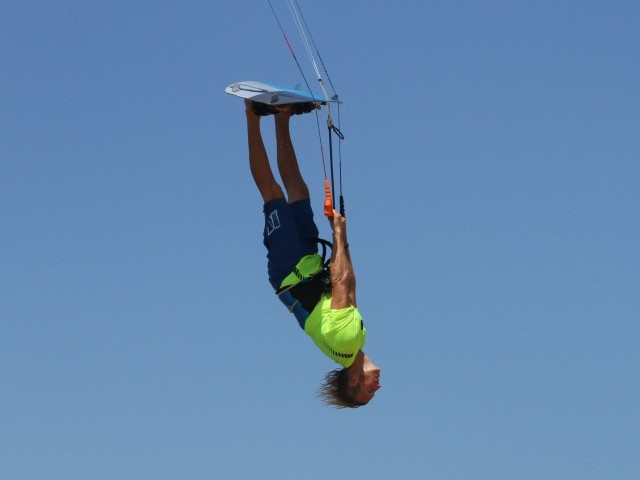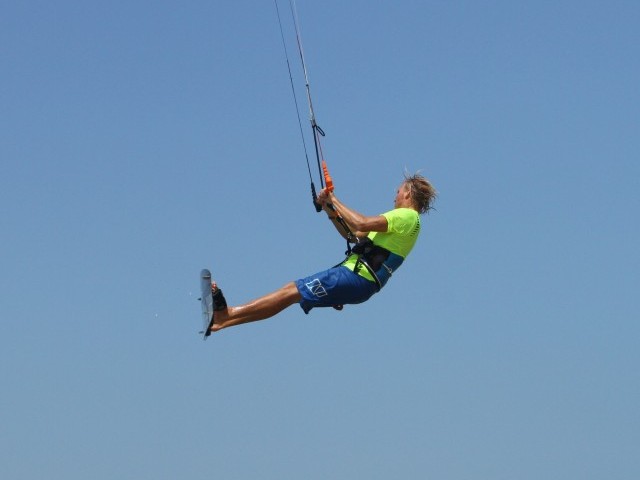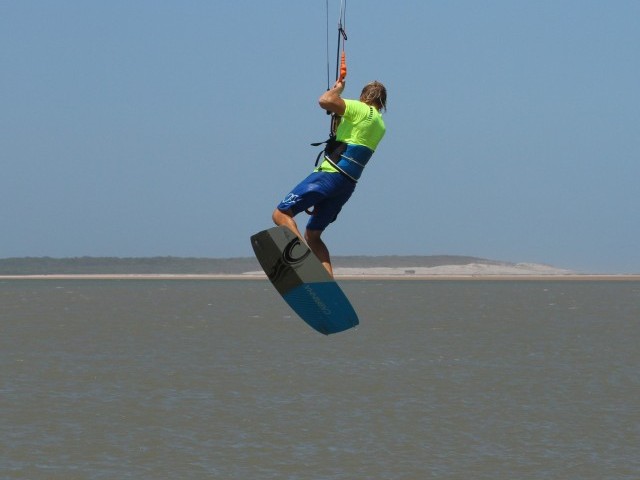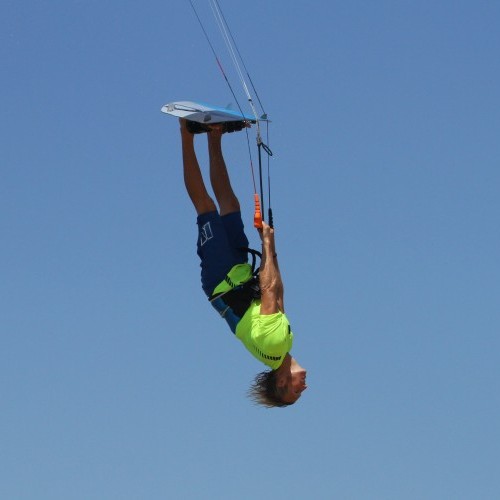
The Stiffy
Technique / Intermediate
Introduction
Here’s one from the dark ages, bringing back memories of two line kites, wrist leashes, long twin tips and even longer swims. The Stiffy is an inverted jump, but compared to today’s boner here both legs are used to push the board up high, kicking the lines with your toe side edge. To really claim it and make it more stylish you can get your head right back so that your body and legs are in line. In short, it’s a Dead Man without letting go of the bar.
This jump is pretty much open to anyone who can happily land a sent jump. As a precaution if this is to be your first attempt at getting upside down, please make sure that the water is deep enough to land head first!! So, let’s have a flick through the separate parts of the Stiffy and see how best you can learn it.
Back to Basics Pic A
Your take off is the most important part of any jump, and as such you should devote some effort into making it work in your favour. You don’t need to go stratospheric to get upside down but it will help if all your energy takes you up rather than swings you downwind. Let’s have a brief recap on how to get that elevator jump in preference to a long one…
First off, you need to be heading upwind on a strong edge, so looking where you want to go, shoulders twisted open, driving against the board whilst pushing it towards the kite. This stance should not slow you down. If you’re slowing, it’s because you’re carving upwind - this should be an A to B line upwind where you’re balanced. Make sure the kite is positioned at about 1 or 11 o’clock as at this height you can still edge. Any higher and the kite will lift you, any lower and you’ll have to work very hard to resist the pull for a longer period of time when you send the kite. Also, make sure that you steer your kite on the sweet spot using both hands - if you yank the bar in it will stall the kite and pull you over and downwind rather than up, up and away. You can see that Christian is edging well, the board is in between him and the kite, he’s twisting upwind whilst sending the kite up and resisting.
Balanced in the Chair Pic B
Once you’ve taken off you need to get balanced and in a position from which you can tip yourself backwards. As far as getting balanced it’s much like any other jump. Christian is pulling his knees up and he’s levelled the bar out to stop the kite moving back and bring it to just about 12 o’clock. This position will offer him the most support, float and balance. Bringing the knees up may, however, feel counterintuitive if you want your legs straight above you. Yet, think of it as falling back on a chair. If you slob straight with your bum near the edge and your legs extended you’d never tip back, whereas if you sit in the chair as was intended, a little push from the legs and drop back of the head and bingo, you’re flat on your back. You can make this easier still by using your arms. Christian is pushing the bar down and lifting his knees towards it whilst looking up at the kite. This brings the fulcrum point towards his waist and harness making the forthcoming inversion easier as he’s working with gravity rather than against it (if you ignore the fact that he’s jumping a kite!)
Look at Your Eyebrows Pic C
In all sports there are many ways to encourage people to move in certain ways and kiting is no different whether we’re punching kangaroos or biting our ears. In this case you’ll be looking at your eyebrows. To get yourself inverting into a Stiffy you’ll need to commit wholeheartedly to going upside down. Looking at Christian you can see that the bar is still in, because he’s using it to lever himself up by pushing down on it. At the same time, he’s thrown his head back, and to fully commit he’s looking at his eyebrows. It’s one thing to put your head back, but another to take your eyes off the kite. He also still has his knees flexed so he can lift them further towards the bar as he rolls back, rather than having to lift the weight of his legs and board. Finally, note how everything is in line, his head is 90 to his shoulders, his hips are parallel to the bar and his feet are lifting equally. This way Christian won’t twist whilst inverting into the Stiffy and will therefore have much more chance of coming down in the same balanced and landable position.
The Stiffy Pic D
Here it is, a Stiffy inversion. Christian has kicked the board up all the way so that it stops against his lines (hopefully no sharp edges). As the feet rise Christian pushes his hands and hips towards each other to bring his bum in. His arms are straight, his shoulders low and he’s no doubt slightly disorientated because all he can see is the water beneath him. Another good reason to keep everything in line. The harder you kick up and the more you thrust your hips towards your hands, the more inverted you’ll be. Your upper body relies on your head and eyes…
Coming Down Pic E
You’ll find that gravity always wins, so no matter how long you’d like to keep your legs up, they’ll drop of their own accord; you need to be ready to control their descent. The key here is to not let everything just drop out of the sky. Much like a Pilates exercise keep your stomach and legs “engaged” and tense so that you lower them in a controlled fashion, again with everything in line so that you don’t get twisted. Christian is still holding the bar in and level so that he can support himself and also keeps tension on the lines. As his feet lower Christian can now look forward to where he thinks he’ll land.
Down and Dive Pic F
Once your undercarriage is fully down it’s business as usual for touch down. Chances are you might be slightly off balance so the harder that you dive the kite, the more it will help as the power will pull you out and down wind for a soft tail first landing. Christian keeps the bar in, and with tension on the back lines he can dive the kite with meaning while focusing on his potential landing.
Top Tips
As you will be supporting yourself on the bar it’s a good idea to trim your sweet spot in towards you if you’re used to riding with it at arms length. The reason being that if your sweet spot is a long way out, when you pull on the bar you will stall your kite, and as a result you will accelerate downwind whilst you’re airborne, and generally speaking this is off putting, especially when you’re in the process of going upside down.
At first concentrate on getting your feet up with your legs a bit bent. Then you can work towards straighter legs, whilst still being able to keep a check on your kite. Once you’re comfortable you can go for the full inversion with your head and body.
You can visualise the movement to get upside down in a chair by pushing your arms down towards your thighs, lifting your chin and rocking your head back and looking for your eyebrows.
Now have a good look at the videos and sequence to get an idea of the complete move.
Common Problems
The most likely unwanted occurrence in this move is that you’ll rotate forwards (as per front roll) as you come out of your Stiffy. This is due to two things:firstly, if you kick heavily into your jump with your back leg it can put you off balance and start a bit of a twist; secondly, and most likely, is the position of the kite. If you leave it too far behind you on the way up it will encourage a slight look back twist on your harness that will be exaggerated by the Stiffy movement, so make sure that you get the kite back above you before throwing your legs up.
Keystones
- Good edge and send for elevator jump.
- Redirect kite towards 12 o’clock as soon as take off.
- Bring knees up and bar down into chair position.
- Thrust hips towards hands, kick up legs, head back &
- Look at your eyebrows.
This technique article was in Issue 56 of IKSURFMAG.
Related
By Christian and Karine
Christian and Karine have been working together as a coaching team, running improver to advanced kitesurfing clinics since 2003.






